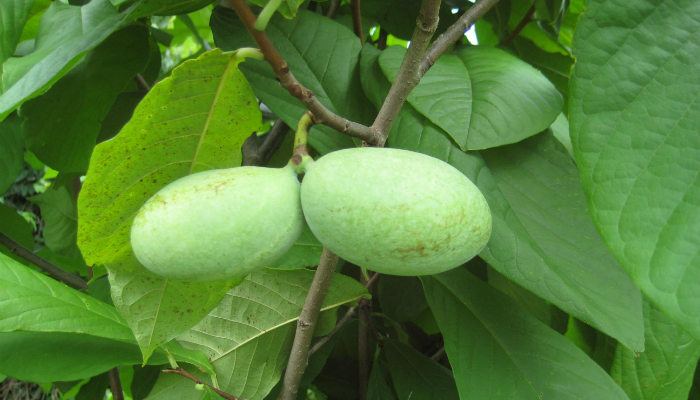Are You Ready for Pawpaw Season?

(caption: Typical pairs of immature pawpaws, usually well-hidden amongst the leaves.)
Are you ready for this year’s pawpaw season? It’s coming up in the next couple of weeks through early September. You don’t want to miss it because pawpaw is appealing both for its tasty fruit as well as for its ability to attract the zebra swallowtail butterfly, whose caterpillar feeds on the leaves. Originally native to the southern three or four tiers of Iowa counties, including Johnson County, pawpaw is now returning, as local folks increasingly plant this little tree.
At Bur Oak Land Trust’s Belgum Grove, we are working to establish pawpaw patches, and if you aren’t familiar with this tree, stop by for a visit. (You’ll have to wait a couple years for the fruit to develop from these pawpaws though!)
But keep in mind that pawpaw fruit is unique and a few picking and eating suggestions may be in order.
If pawpaw fruits are picked green off the tree, they will partially continue the ripening process and get sweeter, but unfortunately still carry part of the bitter aftertaste of the green fruit. To ensure good flavor, let the tree decide – the fruit falls to the ground when ripe. By then the skin will be transitioning from green to yellow and you will have a couple of days of increasing ripeness and intensifying flavor, with the skin turning very yellow and the pulp turning to a custard texture. That’s why this fruit is also called the custard apple. Ripening continues after the fruit falls off the tree, and if you don’t slow down the ripening process through refrigeration, the pawpaw skin starts turning black and the flavor shifts toward caramel or butterscotch, which many people still like. Within another day or two after that, the flavor and odor becomes so intense as fermentation takes over, that most folks no longer want to deal with these fruits.
While the fruit has a brief shelf life, the cleaned pulp freezes very well and I’ve enjoyed it nearly a year later. My favorite? Pawpaw pulp stirred into vanilla ice cream – and I thank Art Bettis for bringing this treat to my attention. I’ve found references to cooking with pawpaw pulp – bread, cookies, pudding, and frozen treats – and invite you to share how you have prepared your pawpaw pulp.
But be aware of the seeds. Many plants that invest in large seeds do not want them to be damaged, and so make them inedible. Pawpaw is one of these, and if you chew into and swallow a seed, it will soon come back up. People familiar with this fruit are comfortable with just picking up a ripe yellow-to-nearly-black pawpaw from the ground, twisting it in half, doing a little taste test for their preferred intensity of ripeness, slurping out the custard, and spitting out the undamaged seeds.
In future years, visitors to Belgum Grove will be welcome to harvest the fruits and they will be able to try just this technique!
Tags: Lon Drake, pawpaw

